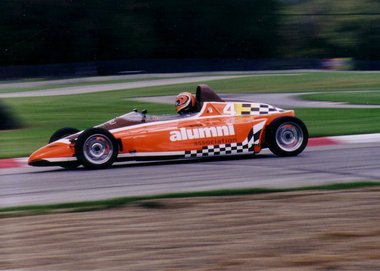
It’s nice when academia and business work together for the future of transportation. It’s even better when the fruit of that synergistic relationship can be displayed and passed on to future generations.
That’s exactly what Bowling Green State University did recently when it donated its blazing orange Electric Falcon, a zero-emissions prototype racing car, to the Crawford Auto Aviation Museum of the Western Reserve Historical Society.
“A primary focus of the Historical Society’s current mission is to tell the stories of northeast Ohio’s automotive entrepreneurship and innovation,” said Dr. Gainor Davis, WRHS president and chief executive officer. “The Electric Falcon is a marvelous addition to our Crawford collection. It enriches our ability to discuss the long history of alternative energy-driven automobiles in our region.”
“The Electric Falcon set the standard for alternative fuels research and product development. It will always be a symbol of our sophisticated research, our commitment to serving society and our dedication to helping the environment,” added Carol Cartwright, president of BGSU.
The Electric Falcon is a unique vehicle.
Design and construction of the vehicle actually started in 1993, according to Anthony Palumbo, chief of operations of the Electric Vehicle Institute at BGSU. Back then, BGSU’s College of Technology accepted a three-year challenge from the Cleveland Electric Illuminating Company and the Solar and Electric Racing Association to build a high-speed electric vehicle.
“We started to do our workshops with our marketing partners in 1993 but didn’t get the chassis until February of 1994,” said Palumbo. “So we basically had to take a rolling body frame and convert it into the first version of the Falcon by July in time for the first race.”
The first version, which put out 80 horsepower at approximately 10,000 rpms, was then tested on a track against 12 other university teams in the Formula Lightning Racing Series. For the next 11 years, as BGSU competed in the series, it took the checkered flag four times out of 27 races. Students and faculty at the Electric Vehicle Institute were able to study and develop the motor, controller and drivetrain components, versions of which can be found in today’s emerging electric vehicles.
“We were one of the first vehicles to use a three-phase AC induction motor right out of the gate,” said Palumbo. “Many other competitors used a more traditional DC drive line.”
Working with marketing partners like Lincoln Electric, the team at BGSU was able to redesign and improve the electric motor to the point where it eventually generated 225 horsepower at 10,000 rpms. The top speed was a whopping 140 miles an hour. This meant that the Electric Falcon had to be driven by a professional race car driver. National SCCA Formula V driver Larry Crosser, piloted the Electric Falcon during its 11 year run.
Another significant innovation pioneered by the team at BGSU was the Falcon’s unique liquid cooling system.
“Anybody can build an 80 horsepower electric motor. The challenge is to make one small enough to get into a car,” said Palumbo. “That’s when we developed our unique liquid cooling system that basically carried us through all of the projects we did at the Electric Vehicle Institute.”
A NASA-sponsored hybrid bus also used BGSU’s motor system.
While it’s now retired at Crawford, the Electric Falcon is still serving the automotive industry as a powerful educational tool, inspiring tomorrow’s automotive engineers who visit the museum.
“We took on this challenge in 1993 to convince the public that electric vehicles are a potential solution to our environmental issues,” said Barry Piersol, assistant to the dean of the BGSU College of Technology. “Through a series of patents that were developed throughout the process, we were quite successful with the race car. We really felt that those accomplishments should live on. The Crawford Auto Aviation Museum has a very strong collection of historic electric vehicles, and the Electric Falcon fits right in.”
It’s truly a marvel of technological development. And it was developed and built right here in Northern Ohio.

